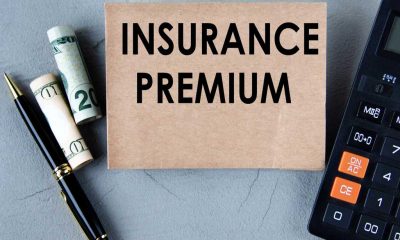Insurance
Tips On How To Choose Homeowners Insurance

If you own a home, homeowners insurance is essential. insurance not only protects your property and personal things financially, but insurance also covers your liability for third-party injuries and property damage.
However, even if you’ve previously had house insurance, selecting the correct policy might be difficult. This thorough guide will help you understand the fundamentals of home insurance, including the many policy types, as well as recommendations for choosing the best homeowners insurance coverage for your specific needs.
Understanding the Basics of Homeowners Insurance
Standard homeowners insurance policies often cover the following:
- Dwelling coverage: Protects your home’s structure, including related structures like as garages, against damage caused by insured risks. Common covered risks include fire, windstorms, hail, and vandalism.
- Personal property coverage: Covers your personal goods, including furniture, appliances, and apparel. If they are damaged or destroyed by a covered risk, or stolen, your insurance will pay for their replacement or repair.
- Liability coverage: Protects you if you are proven legally liable for the injuries or damage to others’ property while on or off your premises.
- Additional living expenses: Covers any additional costs that may arise if your house becomes uninhabitable as a result of a covered loss. Hotel accommodations, meals, and other living expenditures are prominent examples of covered costs.
- Other sutures coverage: Covers all detached structures on your property, including sheds, fences, carports, and detached garages.
Homeowners insurance policies contain limits on covered products and coverage amounts, which vary depending on your preferences, coverage needs, and the type of policy you select. They also have a deductible that you must pay before the coverage begins. Furthermore, most policies either exclude or need separate coverage for certain risks, such as floods and earthquakes.
Types of Homeowners Insurance Policies
Homeowners insurance policies contain limits on covered products and coverage amounts, which vary depending on your preferences, coverage needs, and the type of policy you select. They also have a deductible that you must pay before the coverage begins. Furthermore, most policies either exclude or need separate coverage for certain risks, such as floods and earthquakes.
- HO-1 (Basic Form)
This is the most basic policy kind, covering a small number of risks such as fire, lightning, and explosion. Many insurers do not offer this form of coverage since it is inadequate for the majority of homeowners.
- HO-2 (Broad Form)
This policy covers more risks than the HO-1, including falling objects, damage caused by the weight of ice, snow, or sleet, and unintentional discharge or overflow of water or steam from pipes or appliances.
- HO-3 (Special Form)
This is the most typical homeowners insurance policy, and it includes coverage for the home and other structures, liability, personal property, additional living expenses, and medical payments to others.
An HO-3 protects your property from all hazards except those that are specifically excluded, such as floods, earthquakes, frozen pipes, vandalism in an empty building, pest damage, and defective construction. It protects your personal items from the specific risks listed in the policy.
You can choose whether to insure property at its real cash value or replacement value—the latter provides more coverage in the case of a loss, but is typically more expensive. Certain forms of personal property, such as jewels, firearms, and money, have policy limitations that may not adequately safeguard your valuables. For example, many homeowners who own precious jewelry may choose to purchase jewelry insurance in addition to their homeowners insurance coverage.
- HO-5 (Comprehensive Form)
An HO-5 policy provides the most comprehensive coverage, containing all risks covered by the HO-3 policy, as well as additional coverage for personal belongings. It often has larger coverage levels and is best suited for high-value residences or those with significant personal belongings.
- HO-6 (Condo Insurance)
HO-6 policies are specifically developed for condominium owners, and they cover personal property, liability, and any changes made to the unit.
- HO-8 (Modified Coverage Form)
This policy is meant for older properties or those with historical worth, and it covers named dangers and replacement costs based on the home’s actual cash value rather than its full replacement cost.
Factors to Consider When Choosing Homeowners Insurance
When selecting a homeowners insurance policy, consider the following factors:
- Coverage
Ensure that your policy covers your home’s construction, personal possessions, liabilities, and additional living expenditures. Consider any dangers unique to your area, such as floods or earthquakes, and seek supplemental coverage as needed. Consider the sub-limits on your policy for personal belongings. get a floater for specific things to boost these limitations, or get a separate insurance to provide enough coverage. Consider purchasing an umbrella insurance policy to boost your liability coverage above the limit provided.
- Deductibles
A deductible is the amount you have to pay out of pocket before your insurance kicks in. Higher deductibles often result in reduced rates, but you must be prepared to pay the deductible amount in the event of a claim. You might ask your insurer if your coverage includes a buyback deductible. This provision will raise your premium but may lower your first-dollar deductible for an occurrence.
- Replacement Cost vs. Actual Cash Value (ACV)
Replacement cost coverage pays to repair or replace your home or personal items without regard for depreciation, whereas actual cash value coverage considers depreciation, which may not be sufficient to replace or repair the damage or loss. Replacement cost coverage normally results in bigger payouts but carries a higher premium.
- Discounts
Many insurance companies provide discounts for bundling policies, such as auto and house, adding security systems or fire alarms, owning a newer or well-maintained home, and remaining claim-free for a set period of time. When searching for homeowners insurance, make sure to inquire about any potential reductions.
- Customer Service and Claims
Choose an insurance company that is well-known for providing good customer service and processing claims quickly. Consider customer satisfaction ratings, such as those found in J.D. Power’s U.S. Home Insurance Study, and read reviews of the best homeowners insurance. Also, get suggestions from friends or family members to ensure you choose a reputable insurer.
Tips for Saving on Homeowners Insurance
- Shop around: Obtain quotes from multiple insurance companies to compare coverage, premiums, and deductibles. This can help you find the best policy for your needs at the most competitive price.
- Bundle policies: Many insurance companies offer discounts if you bundle your homeowners insurance with other policies, such as auto or life insurance. That said, in recent years, rising auto insurance costs have made bundling a less effective discount opportunity, according to the 2022 J.D. Power U.S. Home Insurance Study.2 This makes comparing home insurance quotes that much more important.
- Increase your deductible: Raising your deductible can result in lower premiums, but be sure you can afford to pay the higher deductible in case of a claim.
- Improve your home’s security: Installing security systems, smoke detectors, home security cameras, and deadbolt locks can help reduce your premiums by lowering the risk of theft or damage.
- Maintain a good credit score (or improve it): Insurance companies frequently use your credit score to determine your premiums. Maintaining a good credit score can help you qualify for lower rates.
Top Companies Offering Homeowners Insurance
When selecting a homeowners insurance provider, evaluate coverage options, pricing, customer service, and claims processing to discover the best fit for your needs.
State Farm is the largest supplier of homeowners insurance, with more than 18% of the market share in 2022. National Association of Insurance Commissioners. “2022 Property and Casualty Market Share.” According to J.D. Power’s 2022 U.S. Home Insurance Study, the company performed above average.
Important: On May 27, 2023, State Farm stopped taking new house insurance applications in California, as well as all commercial and personal lines property and liability insurance. This adjustment does not affect existing coverage or personal auto insurance policies. State Farm General Insurance Company. “State Farm General Insurance Company: California New Business Update.”
Allstate offers some significant savings on homeowners insurance, including up to 10% off your rate for moving to Allstate (and up to 10% off every year after that), up to 10% off for early renewal, and up to 5% off for automated payments, among others. Online quotations are accessible in some places.
Chubb is an excellent choice for high-value properties or anyone looking for a home insurance coverage with plenty of extras. Chubb provides regular replacement cost coverage for your house and valuables, as well as extended replacement cost coverage, which pays to repair your home to its original condition even if the damage exceeds your policy limits.
Liberty Mutual provides homeowners insurance with a variety of benefits, including a 10% discount when purchased online and savings on newly purchased houses. According to J.D. Power, the company’s customer satisfaction rating is significantly lower than the industry average.
USAA, which exclusively serves military troops, veterans, and their families, provides comprehensive homeowners insurance with exceptional customer service and impressive discounts. It also makes replacement cost coverage a requirement on all insurance.
- How Much Is Homeowners Insurance?
According to the NAIC’s most recent data, the average cost of homeowners insurance in 2022 was $1,311.5 However, the cost of your insurance will be determined by a number of criteria, including the value of your house, its location, the type of policy you purchase, your deductible, coverage limits, discounts available to you, and your claim and credit history.
- How Much Homeowners Insurance Coverage Do I Need?
The amount of coverage required is determined by the value of your home and personal goods, as well as any dangers specific to your area, such as forest fires or storms. It is critical to have enough dwelling coverage to rebuild your home, sufficient personal property coverage to replace your items, and adequate liability coverage to protect your assets. To protect valuable objects or specific risks, you may need to add a special endorsement or purchase a separate policy, such as jewelry insurance or flood insurance.
- Does Homeowners Insurance Cover Flooding?
Flooding is not covered under standard homeowner insurance policies. If you reside in a region prone to flooding, you may need to acquire a separate flood insurance policy from the National Flood Insurance Program (NFIP) or a commercial insurer.
- What Is Not Covered by Homeowners Insurance?
Floods, earthquakes, and ordinary wear and tear are often not covered by homeowners insurance policies. They may also exclude coverage for some high-value objects, including as jewelry or artwork, unless you include a particular endorsement or rider in your policy.
- Does Homeowners Insurance Cover Water Damage?
Yes, if the injury occurs suddenly and unexpectedly. For example, a burst washing machine pipe or a tree crashing through your roof are likely to be covered by your house insurance policy. However, it may not cover damage caused by a continuous roof leak, as this is deemed wear and tear or poor maintenance.
Source: Investopedia.










